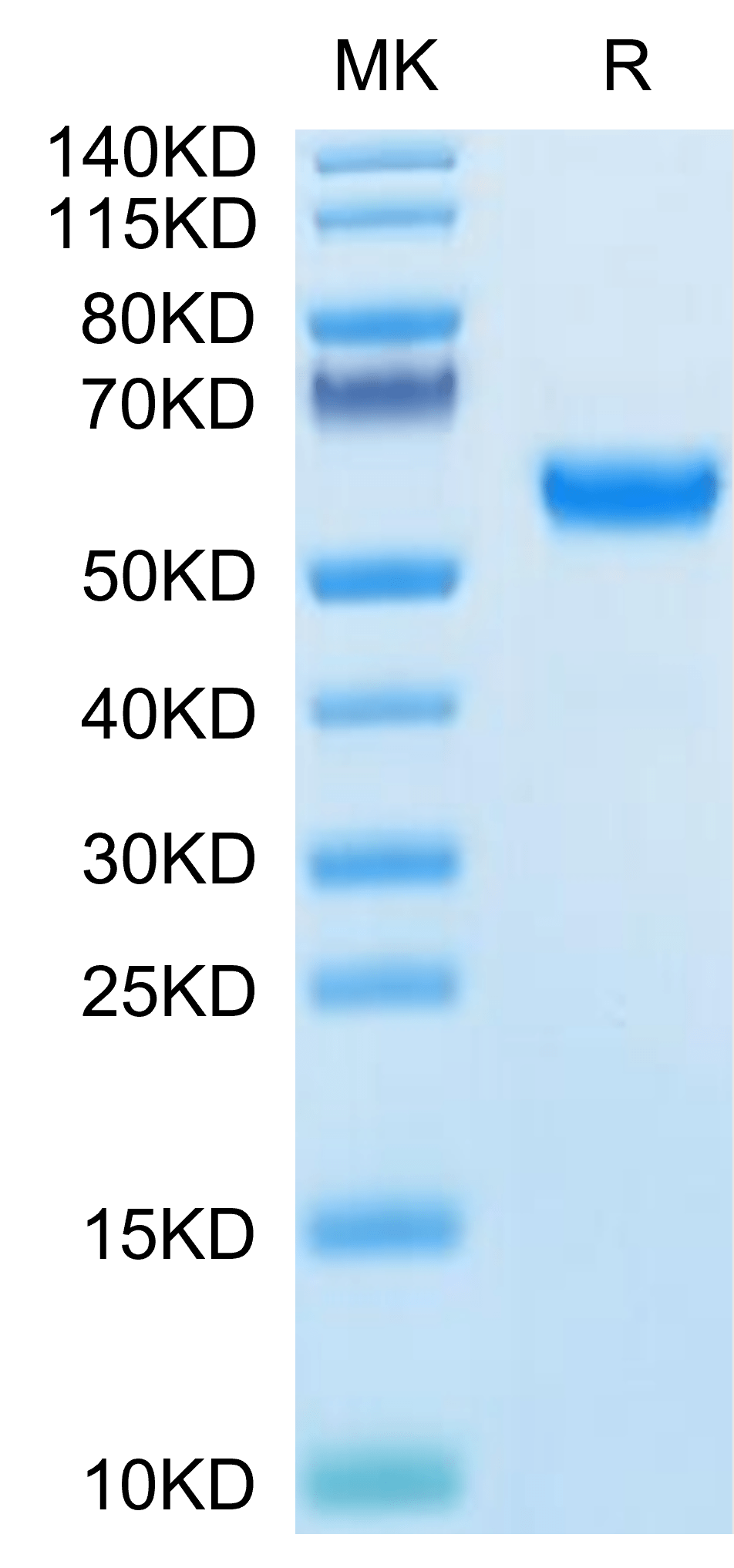| Weight | 1 lbs |
|---|---|
| Dimensions | 9 × 5 × 2 in |
| accession | NP_000573 |
| express system | HEK293 |
| product tag | C-His |
| purity | > 95% as determined by Tris-Bis PAGE;> 95% as determined by HPLC |
| background | Ovarian cancer is one of the most lethal malignant tumors in women. Secreted phosphoprotein 1 (SPP1) plays an important role in some cancer types. The expression of SPP1 was higher in epithelial ovarian cancer tissues than in normal ovarian tissues. Silencing SPP1 decreased the cell proliferation, migration, and invasion. Ectopic expression of SPP1 increased the cell proliferation, migration, and invasion. Silencing SPP1 prevented ovarian cancer growth in mice. Silencing SPP1 inhibited Integrin β1/FAK/AKT pathway. |
| molecular weight | The protein has a predicted MW of 34.8 kDa. Due to glycosylation, the protein migrates to 50-60 kDa based on Tris-Bis PAGE result. |
| available size | 100 µg, 500 µg |
| endotoxin | Less than 1EU per μg by the LAL method. |
Human SPP1/OPN Protein 4033
$300.00 – $1,000.00
Summary
- Expression: HEK293
- Pure: Yes (HPLC)
- Amino Acid Range: Ile17-Asn300
Human SPP1/OPN Protein 4033
| protein |
|---|
| Size and concentration 100, 500µg and lyophilized |
| Form Lyophilized |
| Storage Instructions Valid for 12 months from date of receipt when stored at -80°C. Recommend to aliquot the protein into smaller quantities for optimal storage. Please minimize freeze-thaw cycles. |
| Storage buffer Shipped at ambient temperature. |
| Purity > 95% as determined by Tris-Bis PAGE |
| target relevance |
|---|
| Ovarian cancer is one of the most lethal malignant tumors in women. Secreted phosphoprotein 1 (SPP1) plays an important role in some cancer types. The expression of SPP1 was higher in epithelial ovarian cancer tissues than in normal ovarian tissues. Silencing SPP1 decreased the cell proliferation, migration, and invasion. Ectopic expression of SPP1 increased the cell proliferation, migration, and invasion. Silencing SPP1 prevented ovarian cancer growth in mice. Silencing SPP1 inhibited Integrin β1/FAK/AKT pathway. |
| Protein names Osteopontin (Bone sialoprotein 1) (Nephropontin) (Secreted phosphoprotein 1) (SPP-1) (Urinary stone protein) (Uropontin) |
| Protein family Osteopontin family |
| Mass 35423Da |
| Function Major non-collagenous bone protein that binds tightly to hydroxyapatite. Appears to form an integral part of the mineralized matrix. Probably important to cell-matrix interaction. {ECO:0000250|UniProtKB:P31096}.; Acts as a cytokine involved in enhancing production of interferon-gamma and interleukin-12 and reducing production of interleukin-10 and is essential in the pathway that leads to type I immunity. {ECO:0000250|UniProtKB:P10923}. |
| Subellular location Secreted {ECO:0000269|PubMed:25326458, ECO:0000269|PubMed:36213313, ECO:0000269|PubMed:37453717}. |
| Tissues Detected in cerebrospinal fluid and urine (at protein level) (PubMed:25326458, PubMed:36213313, PubMed:37453717). Bone. Found in plasma. {ECO:0000269|PubMed:25326458, ECO:0000269|PubMed:36213313, ECO:0000269|PubMed:37453717}. |
| Structure Interacts (via N-terminus) with integrin ITGA9:ITGB1. {ECO:0000250|UniProtKB:P10923}. |
| Post-translational modification Forms covalent cross-links mediated by transglutaminase TGM2, between a glutamine and the epsilon-amino group of a lysine residue, forming homopolymers and heteropolymers, increasing its collagen binding properties. {ECO:0000250|UniProtKB:P31096}.; Extensively phosphorylated by FAM20C in the extracellular medium at multiple sites within the S-x-E/pS motif (PubMed:15869464, PubMed:22582013, PubMed:26091039). The phosphorylated form inhibits hydroxyapatite crystallization. Dephosphorylation via a mechanism involving ALPL/TNAP promotes hydroxyapatite crystallization (By similarity). {ECO:0000250|UniProtKB:P10923, ECO:0000269|PubMed:15869464, ECO:0000269|PubMed:22582013, ECO:0000269|PubMed:26091039}.; O-glycosylated. Isoform 5 is GalNAc O-glycosylated at Thr-59 or Ser-62. {ECO:0000269|PubMed:15869464, ECO:0000269|PubMed:23234360, ECO:0000269|PubMed:25326458}. |
| Target Relevance information above includes information from UniProt accession: P10451 |
| The UniProt Consortium |
Data
 |
| The purity of Human SPP1 is greater than 95% as determined by SEC-HPLC. |
 |
| Human SPP1 on Tris-Bis PAGE under reduced condition. The purity is greater than 95%. |
Publications
Publications
| pmid | title | authors | citation |
|---|---|---|---|
| We haven't added any publications to our database yet. | |||
Protocols
| relevant to this product |
|---|
Documents
| # | ||
|---|---|---|
| Please enter your product and batch number here to retrieve product datasheet, SDS, and QC information. | ||














